El Corazon de Cuba
Educational Program
Trinidad
 Towards
Trinidad the road gets closer to the ocean. Generally the shore is a limestone platform sitting above the water.
Occasionally there are inlets, which are more likely to have a sandy beaches. At the mouth of the Yaguanabo River
is a nice motel. Besides its pleasant location and ambience, it has solar water heaters. Though Cuba
tends to have various energy shortages, use of solar and other alternative energy sources
is not wide spread. Few fixtures, few outlets, and compact florescent bulbs tend to be the most common
example of energy conservation.
Towards
Trinidad the road gets closer to the ocean. Generally the shore is a limestone platform sitting above the water.
Occasionally there are inlets, which are more likely to have a sandy beaches. At the mouth of the Yaguanabo River
is a nice motel. Besides its pleasant location and ambience, it has solar water heaters. Though Cuba
tends to have various energy shortages, use of solar and other alternative energy sources
is not wide spread. Few fixtures, few outlets, and compact florescent bulbs tend to be the most common
example of energy conservation.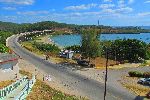
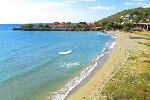
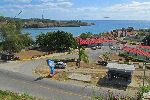

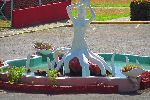
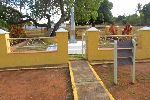
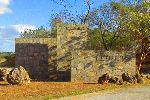
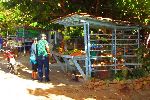 Roadside
small private business (a fresh fruit and vegetable stand) and historical markers and monuments.
Roadside
small private business (a fresh fruit and vegetable stand) and historical markers and monuments.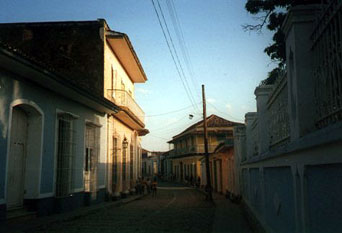
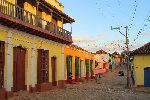
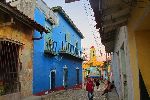 Trinidad
sits up on the side of a hill, several kilometers from the ocean, and
beaches. It was founded 1514, by the brutal conquistador Diego
Velázquez de Cuéllar. It was the third town founded by the Spanish
Crown in Cuba. Velázquez had previously
founded Baracoa and Santiago de Cuba, and later founded Havana.
Trinidad
sits up on the side of a hill, several kilometers from the ocean, and
beaches. It was founded 1514, by the brutal conquistador Diego
Velázquez de Cuéllar. It was the third town founded by the Spanish
Crown in Cuba. Velázquez had previously
founded Baracoa and Santiago de Cuba, and later founded Havana.
Its legacy of artisans, a new merchant class, and beautiful houses, with large doors and hardwood windows frames, and spacious courtyards, and paved streets, began developing in the early nineteenth century. It is a magnet for photography.
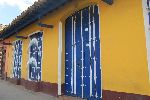
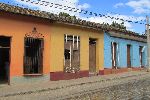
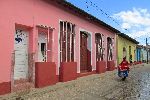
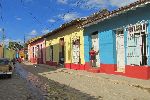
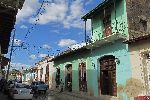
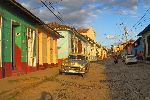
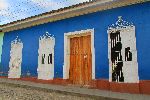
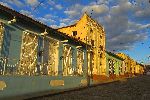
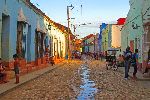
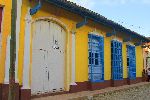
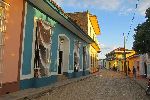
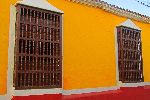
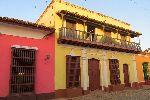
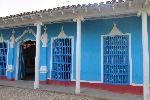
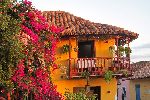
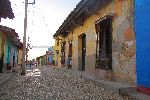
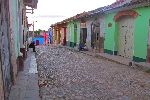
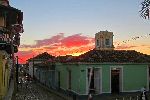
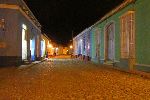
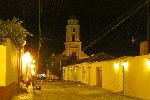
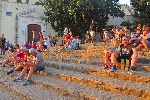 Old
Trinidad is now
dominated (and perhaps over-populated) most days by tourists. In response, most enterprise is oriented toward itinerants. There are
lots of small hostel-type hotels and rental rooms, a number of music
clubs, assorted paladars (private restaurants specializing in meals that are more than rice and beans,
or pizza), tourism hustlers, and countless curio sellers - T-shirts are available. At times and
place in the center, local Cubans clients are rare, or severely outnumbered by visitors. Because of Trinidad's orientation
towards tourism, if you tune to it, you can feel some of the apartheid that hovers around tourism in Cuba.
Old
Trinidad is now
dominated (and perhaps over-populated) most days by tourists. In response, most enterprise is oriented toward itinerants. There are
lots of small hostel-type hotels and rental rooms, a number of music
clubs, assorted paladars (private restaurants specializing in meals that are more than rice and beans,
or pizza), tourism hustlers, and countless curio sellers - T-shirts are available. At times and
place in the center, local Cubans clients are rare, or severely outnumbered by visitors. Because of Trinidad's orientation
towards tourism, if you tune to it, you can feel some of the apartheid that hovers around tourism in Cuba.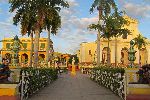
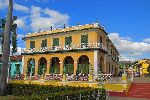
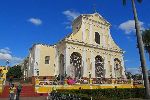
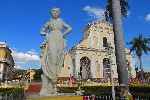
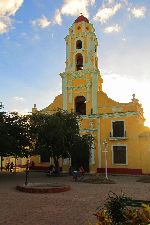
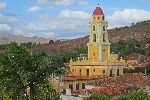 Some
of the landmarks in the town center (above, left to right) are :Plaza Mayor, Palace of Count Brunet
(now the Romantic Museum), Church Santisima Trinidad (Church of the Holy
Trinity),
statue of Terpsichore (muse of dance and music) and San Francisco de Asis.
Some
of the landmarks in the town center (above, left to right) are :Plaza Mayor, Palace of Count Brunet
(now the Romantic Museum), Church Santisima Trinidad (Church of the Holy
Trinity),
statue of Terpsichore (muse of dance and music) and San Francisco de Asis.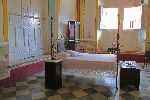
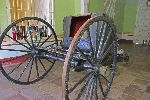
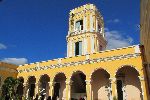
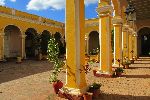 The
Trinidad
Historical Museum, formerly Palacio de Cantero, is another
converted private mansion. Much of the museum is dining room, bedroom, kitchen
and public area furnishings from the colonial period. There are also exhibits on
the sugar economy, slavery, colonial government and culture.
The
Trinidad
Historical Museum, formerly Palacio de Cantero, is another
converted private mansion. Much of the museum is dining room, bedroom, kitchen
and public area furnishings from the colonial period. There are also exhibits on
the sugar economy, slavery, colonial government and culture.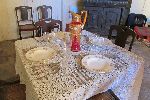
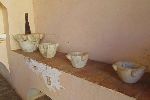
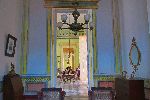
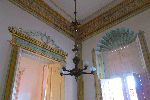
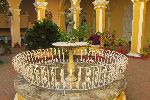
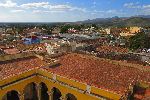
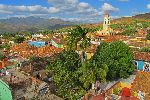
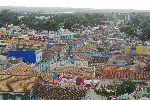
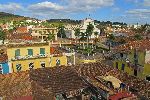
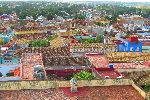
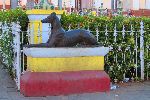
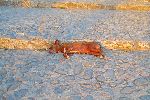
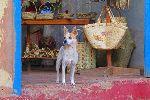
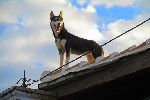 Whether
it is dog statures, guard dogs, shop dogs, or resting dogs, dogs are part of the
scene in Trinidad. There are dozens of public dogs sharing the public spaces. They
are very calm and some like a good rub down.
Whether
it is dog statures, guard dogs, shop dogs, or resting dogs, dogs are part of the
scene in Trinidad. There are dozens of public dogs sharing the public spaces. They
are very calm and some like a good rub down.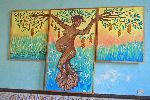
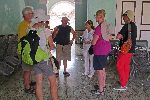 Every province has at least one Maternity
Health Center to serve pregnant women. The are live-in clinics for woman
from outlying area, and for local woman who are have problem pregnancies. Life
for the residence seems to alternate between resting and relaxing, socializing
with each other. The staff has individual plans for monitoring the residence,
especially those that are at the center because of a high risk factors.
Maternity centers would be in the category of another expression of Cuba's
proactive, outcome oriented, preventative health philosophy.
Every province has at least one Maternity
Health Center to serve pregnant women. The are live-in clinics for woman
from outlying area, and for local woman who are have problem pregnancies. Life
for the residence seems to alternate between resting and relaxing, socializing
with each other. The staff has individual plans for monitoring the residence,
especially those that are at the center because of a high risk factors.
Maternity centers would be in the category of another expression of Cuba's
proactive, outcome oriented, preventative health philosophy.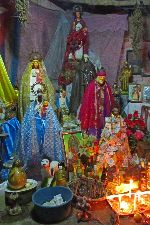
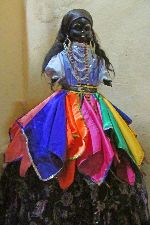
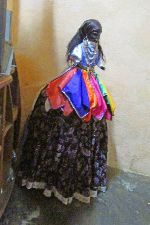

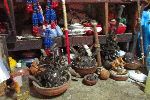 While not unique to Trinidad, this is where we got our best look at Santaria. Santaria is a form of Christianity that merges similar West African deities and
saints brought by the slaves with the saints of Christianity. The shrines draw from both
traditions and are full of symbolism. Santaria has a corps of learned priest and priestess
who lead other believers in the practice of the religion. At the shrine we visited
the priest who was very accommodating in answering our questions and explaining the elements
of the shrine. Most of the objects had direct symbolism and meaning.
While not unique to Trinidad, this is where we got our best look at Santaria. Santaria is a form of Christianity that merges similar West African deities and
saints brought by the slaves with the saints of Christianity. The shrines draw from both
traditions and are full of symbolism. Santaria has a corps of learned priest and priestess
who lead other believers in the practice of the religion. At the shrine we visited
the priest who was very accommodating in answering our questions and explaining the elements
of the shrine. Most of the objects had direct symbolism and meaning.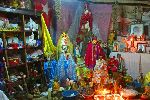
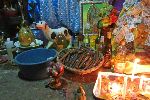
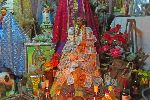
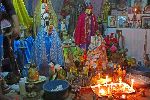
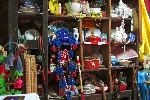
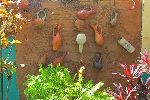
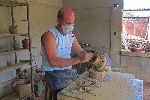
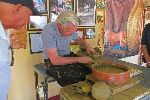
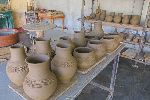
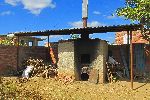
Santander Pottery factory. Trinidad is known for its pottery. This factory has been in the family since it opened in the 1892.
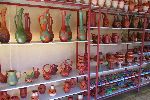
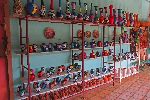
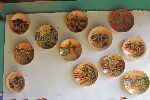
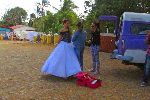

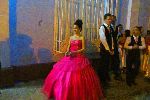
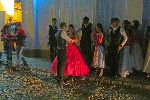
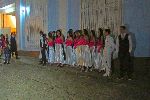
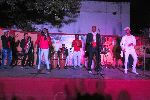
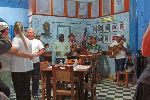 Cuba,
and especially Triinidad, has one of the richest musical landscapes on the planet: Afro-Cuban jazz,
Bolero (filin), Canción, Chachachá, Charanga, Conga, Contradanza, Criolla,
Cubatón, Danzón, Guajira, Guaracha, Hip hop, Mambo, Mozambique, Nueva trova,
Pachanga, Pilón, Pregón, Punto guajiro, Rock, Rumba (guaguancó, columbia,
yambú, batá-rumba, guarapachangueo), Son (montuno), Songo, Timba, and Trova.
It is a rare night that you don't have a choice between several performances in
town.
Cuba,
and especially Triinidad, has one of the richest musical landscapes on the planet: Afro-Cuban jazz,
Bolero (filin), Canción, Chachachá, Charanga, Conga, Contradanza, Criolla,
Cubatón, Danzón, Guajira, Guaracha, Hip hop, Mambo, Mozambique, Nueva trova,
Pachanga, Pilón, Pregón, Punto guajiro, Rock, Rumba (guaguancó, columbia,
yambú, batá-rumba, guarapachangueo), Son (montuno), Songo, Timba, and Trova.
It is a rare night that you don't have a choice between several performances in
town.
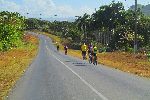
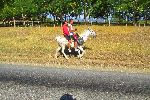
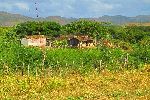
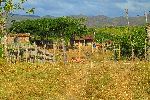
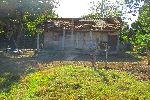

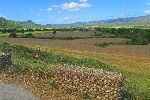
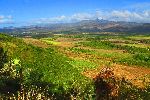
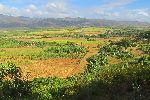 El
Valle de los Ingenios or Valley of the Sugar Mills. It is actually three
connected valleys; San Luis, Santa Rosa, and Meyer. It was a center for
sugar production from the late 18th century until the abolition of slavery
in the late 19th century. At the peak of the industry in Cuba there were
over fifty sugar cane mills in operation in the three valleys, with over
30,000 slaves working in the mills and on the sugar cane plantations that
surrounded them.
El
Valle de los Ingenios or Valley of the Sugar Mills. It is actually three
connected valleys; San Luis, Santa Rosa, and Meyer. It was a center for
sugar production from the late 18th century until the abolition of slavery
in the late 19th century. At the peak of the industry in Cuba there were
over fifty sugar cane mills in operation in the three valleys, with over
30,000 slaves working in the mills and on the sugar cane plantations that
surrounded them.
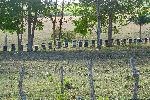 A
long row of beehives, in a line of trees, near the road, is a reminder that
honey once was one of the top exports from the Trinidad region.
A
long row of beehives, in a line of trees, near the road, is a reminder that
honey once was one of the top exports from the Trinidad region.
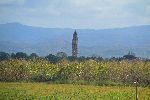
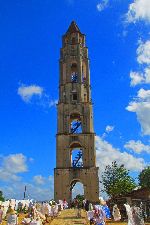 Manacas Iznaga Tower: It was constructed sometime in 1816 by the owner, Alejo Maria
Iznaga y Borrell. Legend says tower was made as a jail for an unfaithful
wife, or in competitions between two brothers for a woman, or as a lookout
over the valley. The bell that formerly hung on top of the tower, that now
rest at the foot, announced the beginning and the end of the work day for
the slaves, as well as the times for prayers to the Holy Virgin in the
morning, midday, and afternoon. It was also used to sound an alarm in case
of fire or slave escape.
Manacas Iznaga Tower: It was constructed sometime in 1816 by the owner, Alejo Maria
Iznaga y Borrell. Legend says tower was made as a jail for an unfaithful
wife, or in competitions between two brothers for a woman, or as a lookout
over the valley. The bell that formerly hung on top of the tower, that now
rest at the foot, announced the beginning and the end of the work day for
the slaves, as well as the times for prayers to the Holy Virgin in the
morning, midday, and afternoon. It was also used to sound an alarm in case
of fire or slave escape.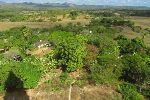
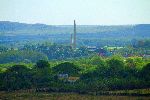
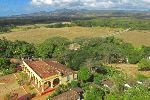
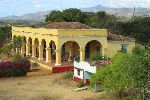
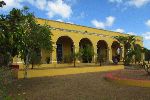
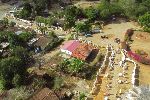
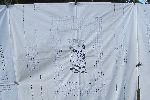
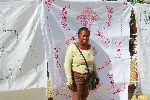 craftspeople of Trinidad drawn thread embroidery, traditional craftwork, of Canarian origin.
craftspeople of Trinidad drawn thread embroidery, traditional craftwork, of Canarian origin.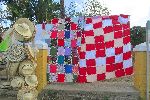
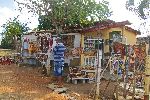
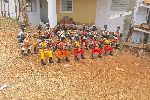
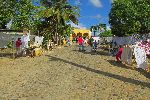
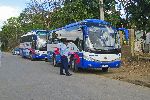
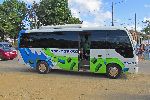

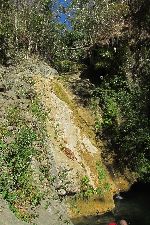
 Trinidad is also were we had an opportunity to take a horseback ride and
hike to a waterfall. Horses are common in rural Cuba, generally as work animals
rather than recreation equipment. The horses we had were very mild
mannered and well
behaved. The hike to the waterfall, along the river was a verdant delight. Thewaterfall is set in a
lush glen where the river falls over the edge of a limestone cliff. Most of our
group availed themselves of the opportunity for a swim at the waterfall. The water
was warm enough to stay in for a while and still enjoy it. One of the fun and unique
features of this waterfall is you can swim into a cave behind the waterfall and then swim
out through the cascade. I looked for bats and other creatures in the cave but didn't see
any. None-the-less it was a novel experience.
Trinidad is also were we had an opportunity to take a horseback ride and
hike to a waterfall. Horses are common in rural Cuba, generally as work animals
rather than recreation equipment. The horses we had were very mild
mannered and well
behaved. The hike to the waterfall, along the river was a verdant delight. Thewaterfall is set in a
lush glen where the river falls over the edge of a limestone cliff. Most of our
group availed themselves of the opportunity for a swim at the waterfall. The water
was warm enough to stay in for a while and still enjoy it. One of the fun and unique
features of this waterfall is you can swim into a cave behind the waterfall and then swim
out through the cascade. I looked for bats and other creatures in the cave but didn't see
any. None-the-less it was a novel experience.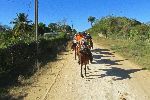
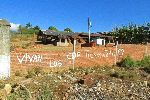
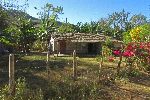
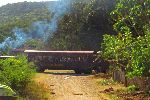



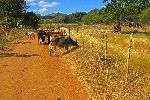
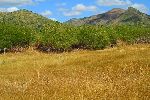
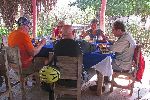
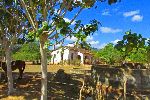
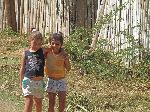
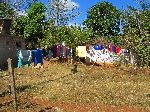
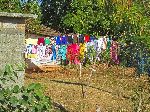 Weekends are laundry day. Passing through towns, villages, and the countryside, it is
easy to pick up the pattern of people scrubbing laundry, ringing laundry,
and hanging it out to dry – even when the skies look threatening. We gain
some insight in the people and the homesteads get added bright colors.
Weekends are laundry day. Passing through towns, villages, and the countryside, it is
easy to pick up the pattern of people scrubbing laundry, ringing laundry,
and hanging it out to dry – even when the skies look threatening. We gain
some insight in the people and the homesteads get added bright colors.
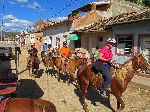
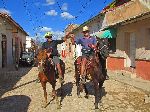




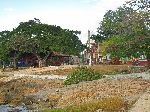







![]() Please write if you have questions, comment, criticism, praise or
additional information for us, find a bad link or would like to be added to IBF's mailing list. (Also let
us know how you found this site.)
Please write if you have questions, comment, criticism, praise or
additional information for us, find a bad link or would like to be added to IBF's mailing list. (Also let
us know how you found this site.)
![]() IBF Homepage
IBF Homepage
![]() Cuba
Homepage
Cuba
Homepage ![]() Search
ibike
Search
ibike



